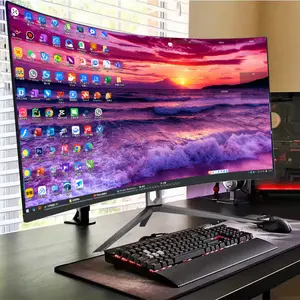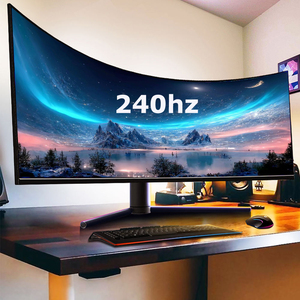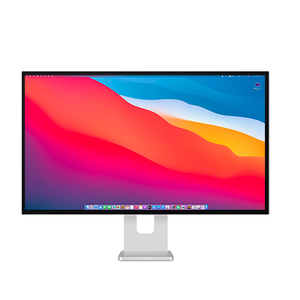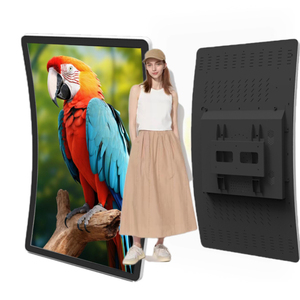(333642 products available)

































































































































































































































A monitor is an output device that displays information from a computer. It's sometimes called a screen or visual display terminal. Like TVs, computer monitors show images from logical machines using similar technology. However, the pictures on a computer screen usually come from a computer rather than a TV station.
The word 'monitor'' can refer to both the physical apparatus (the actual hardware) and the logical, virtual, or symbolic content (the data the apparatus shows). Monitors come in various shapes and sizes, but most are flat panels that use LCD or LED technology. There are many different types of computer monitors available today.
The term ''monitor'' encompasses several kinds of devices, including screens for laptops, tablets, and smartphones. Regardless of the size or type, all monitors serve the same basic purpose: displaying information generated by a computer system for users to see and interact with visually.
The global market for computer monitors was estimated at US $115.9 billion, and it is predicted to grow at a compound annual growth rate (CAGR) of 4.8% from 2023 to 2030. People and businesses will always need computer monitors as they adapt to new technologies. Monitor suppliers should stay up to date with design trends and emerging technology, like screens that can display multiple windows simultaneously.
Understanding what features buyers are looking for can help strategic sourcing. Features that are a must for some buyers are preferences for others. Find out what features are a must for target buyers:
With its wide uses, the monitor has numerous applications across industries and functions. It's vital to know the many areas where the equipment can be applied strategically.
Enterprise Environment
The company remarkably employs the product in day-to-day activities. Its usage is vast, from displaying enticing advertisements to providing essential data on the performance of various business sectors. Business owners can help in making important decisions by analyzing market trends visually. In the corporate world, numerous strategic engagements require the effective presentation of data through clear visual aids. Notably, interactive touch screens have transformed the way people used to participate in meetings previously. They enable sharing of ideas clearly and concisely.
Education Sector
The above monitors play an instrumental role in the education sector. By providing information in a clear and precise manner, they help create an engaging and effective learning environment. Furthermore, in the institution setup, fostering collaboration and enhancing students' participation are remarkable benefits. They aid awareness in different topics due to dynamic and interactive nature presentations. In addition to that, simplifying complex ideas is made easy through visual articulation of concepts.
Control Room Application
Operational overview and surveillance are crucial and require fast decision-making. Accomplishing this needs precise and accurate data interpretation, which is possible with the existence of **high-definition monitors**. Applications such as air traffic supervision, power grid monitoring, and marine navigation rely heavily on this equipment. Using multiple screens increases efficiency in processing huge data volumes.
Medical Setting
In the healthcare industry, the monitor is vital for many tasks, including diagnostic imaging, electronic health records, and vital sign monitoring. For example, a good ECG monitor must have a clear display to show waveforms and beats. Surgeons depend on the above device to display detailed and accurate graphics during complex procedures. Post-operative patients' status is typically monitored and tracked on computer screens by healthcare providers.
Gamers
The gaming industry heavily relies on monitors to showcase colorful graphics and high-resolution details. Modifiers with a high refresh rate and low reaction time are commonly excellent for gaming. Precise visuals and real-time rendering provide a competitive edge to gamers. Moreover, a multi-screen setup enhances the traditional gaming experience into a more exciting and engaging way.
The first thing retailers should consider when buying computer monitors for their customers is the resolution. 4K monitors are becoming more popular because they provide greater picture quality. However, some customers may still prefer full HD monitors. Whichever the case, retailers should stock monitors that suit both high and normal resolution preferences.
Many manufacturers of computer monitors offer a variety of choices when it comes to panel technology. Retailers might need to familiarize themselves with each option's benefits and drawbacks before making a purchase. For example, IPS panels are well known for their superior color black levels and viewing angles. VA panels, on the other hand, provide better contrast ratios. TN panels, in contrast, are favored for their quick response times. They are commonly utilized in gaming circumstances. All things considered, retailers must balance the various advantages and disadvantages of each monitor when placing orders.
When placing orders, retailers must be aware of the monitor's connectivity options. In addition to DisplayPort and HDMI, today's monitors support a wide range of connectivity options. Many devices, like gaming consoles and laptops, now mainly link through USB-C connections. When making their orders, retailers must confirm that the monitor is compatible with the devices that their customers want to use.
In addition to being aesthetically pleasing, ultrawide monitors increase productivity by allowing users to multitask effectively. Retailers should consider ordering these types of monitors because they are appealing to videographers, gamers, and financial analysts, among other professionals.
A critical step in the purchase decision is understanding the target market. Are the monitors primarily for gaming, office work, general use, or professional creative work? Knowing the audience will heavily influence the decisions made regarding size, resolution, refresh rate, and other specifications.
Seeking reputable wholesale computer monitor suppliers is the next logical step after setting up an ideal market strategy. Look for brands and distributors with excellent customer support and a track record of high-quality products.
Q1 What is the difference between a TV and a monitor?
A1 The main differences between a monitor and a TV are functionality and size. Generally, TVs tend to be larger than monitors, but this is not always the case. A monitor may be bigger than a TV. The second difference is that TVs usually have tuners to watch cable or antenna programs, while monitors do not. Another big difference is the resolution. TVs tend to have lower resolutions than monitors. A monitor has higher resolution to display detailed images from a computer.
Q2 Can a gaming console be connected to a monitor?
A2 Yes, the gaming console can be connected to a monitor using an HDMI cable.
Q3 What type of monitor is best for gaming?
A3 A gaming monitor with a TN panel is the fastest and most responsive. It has rapid refresh rates and response times. A gaming monitor with an IPS panel provides great images and excellent viewing angles. It has moderate refresh rates and response times. A gaming monitor with an VA panel provides deep graphics and excellent contrast. It Has moderate refresh rates and response times.
Q4 What is the most important feature of a monitor?
A4 The screen size and resolution are important features of a monitor. Size helps to view more content at once, and the resolution helps see more detail clearly.
Q5 What is the lifespan of a PC monitor?
A5 A average good-quality PC monitor can last five to ten years. However, with regular maintenance and care, it can last longer.